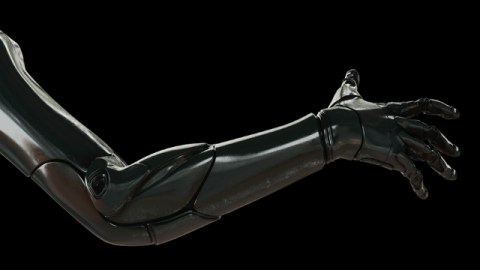Wanting to be an Amputee

It’s France, 1785. An Englishman offers a surgeon money to perform a pretty standard operation: leg amputation. However, for the surgeon, there is no good medical reason to do so, since the man and his leg appear healthy. That the money and leg belong to the same person is irrelevant. Money changes to a loaded gun and the surgeon is forced to operate at gunpoint. It is revealed the man sacrificed his leg to win the heart of the one-legged woman he loved. He wrote to the doctor “You have made me the happiest of all men by taking away from me a limb”. According to neurobiologist Mo Costandi this is the first documented case* of Body Integrity Identity Disorder (BIID).
The website biid.org describes the condition as affecting “a small percentage of the population [of the world] and is commonly manifested by a desire to have an amputation of a specific body part. In most cases, the limb that the person would like to remove is actually in healthy working order and there are no physical problems with it.” Hence, for surgeons there is no ‘reason’ to cut the limb off. I think this is the wrong way to view this.
Sufferers from BIID, reports clinical psychiatrist Michael First, say that “Every minute of my life I feel like something is wrong”. But First qualifies: “It doesn’t impair their ability to relate to other people. They are completely in touch with reality.” The only problem is dealing with constant, gnawing and overwhelming feelings that their bodies are ‘incorrect’. Jesse Ellison summarises it: “They describe a persistent, torturous chasm between their mind’s image of their own body, and the physical body they inhabit. They say their urge to ‘right’ themselves is overwhelming.”
The reason appears to be that one’s body doesn’t recognise the limb as part of the body. I’m summarising Mo Costandi now, since this is his field as neurobiologist: In a study by the well-renowned VS Ramachandran and colleagues, they prodded the legs of BIID sufferers wanting leg amputation. Using magnetoencephalography – “a non-invasive neurophysiological technique that measures the magnetic fields generated by neuronal activity of the brain” – while prodding, they found initial sensory information did not integrate with other bodily sensory information to construct a ‘body image’. It registered in the somatosensory cortex, “where sensory information from the leg is initially processed”, but not the superior parietal lobe, where integration takes place. “These findings suggest that BIID occurs as a result of a discrepancy between the body image and the physical form of the body, which would create cognitive dissonance, or contradictory thoughts and feelings.”
BIID sufferers are willing to do anything to relieve themselves of the condition: whether it’s freezing their legs completely off or to force surgery, blow legs off with a shotgun, or spending time and money travelling to, for example, Mexico to have it done illegally. Many cases cannot be solved with just psychological treatment. For example, after ‘John’ revealed to his wife of 47 years, that he wanted his healthy leg gone, “She asked me and said ‘you know, you’re a rational man, you should be able to deal with this”. Reporting on his case, FoxNews reports: “Most people think anyone who wants to amputate a healthy limb has to be crazy — but John said that is certainly not the case. He said he has seen several psychiatrists, and all of them have concluded that he’s perfectly sane. ‘They said there’s nothing else wrong with me — I just have this odd sort of dependency.’ ” This confirms what Professor First said above.
As we’ve noted, though, there is good reason to think there is a neurobiological explanation. Some have it in more severe degrees than others, which is why some can compensate using wheel-chairs, fake limps and so on, whereas others will take an axe to the target limb. To try minimise this unnecessary damage, it would be better if a medical professional could perform the operation rather than the anxious BIID sufferer.
It seems that people like Costandi, Tim Bayne and Neil Levy, are correct to conclude that surgeons should be allowed to amputate healthy limbs, upon patient request.
Being Hesitant Does Not Mean Being Against
There are reasons to be hesitant. Is there actually informed consent for the operation? Just because a patient requests something does not mean that he or she is (1) informed and (2) capable of being informed. For example, if a man has been thoroughly scorned by a wife or girlfriend, it seems we should be hesitant to help him suddenly get a vasectomy or sterilise himself – even if he requests it. Unless he has been making such requests for some time, it is probably not advisable to act upon the raging impulses of a scorned lover. This is why in the first case of BIID, in the first paragraph, I agree with the surgeon’s refusal.
But notice that this problem of informed consent isn’t magicked away by refusing to have it at all: just as making something illegal doesn’t mean it vanishes. Because the surgeon refused to perform the operation, the Englishman drew a gun. They will draw it on themselves or others, due to the suffering they’re enduring. Why can’t limb amputation be seen in the same light as other operations, such as sex-changes or even plastic surgery (note: “same light” doesn’t necessarily mean the scenarios have the same problems)? Indeed, unlike a sex-change or plastic-surgery, removing a limb is easier to attempt for a sufferer – making it all the more necessary as an accepted medical procedure.
And there is probably a higher percentage of people who obtain plastic surgery and remain unfulfilled, than those who get limbs amputated and feel ‘whole’ – as most BIID sufferers report after having the limb removed. (I’ve not been able to find data to support the contrast, only the individual scenario, so any would be appreciated either to disprove or support this claim.)
BIID sufferers deserve respect for their rationality and autonomy as much as any patient, when such properties are in evidence. Repugnance for their disorder does not mitigate that disorder, nor help the patient; it simply pacifies the medical fraternity’s outrage, prevents BIID sufferers from relief and drives them towards shotguns, freezers, and back-alley surgeries. Robert C. Smith, who performed amputations for two BIID patients a few years ago, claimed this exact reasoning: wanting to help his patients because he wanted to prevent them attempting life-threatening alternatives.
Like any medical procedure and policy, there are of course always going to be problems. For example, if the person is the bread-winner of the family and works with both hands, the operation might make it impossible for the family to survive; the sufferer might not have anyone to support her during their transition; or she can’t handle the lifestyle change. These are all concerns that must be taken into account. But note something important: these are all reasons to make it legitimate – whether that means legal or decriminalised – so that actual professionals can help BIID sufferers with such transitions and problems, making sure all these important factors are pointed out and managed. Furthermore, some might be persuaded out of it, particularly if the dissonance between their body image and the acknowledgement of the target limb is not as severe as other patients’.
Therefore, I think more medics ought to change their minds about this, in order to help BIID sufferers – whether through open and frank discussion or through actual operation. I think even just knowing that the operation is possible might make silent sufferers more open and able to discuss it, so that they do not make terrible decisions that negatively affect their and their loved ones’ lives.
*UPDATE: As per the 1785 story in the first paragraph, Dan O’Connor points out on Twitter the problem with considering it an example of BIID:
Doing it for love is definitely not BIID (which is where you *believe* your body is wrong).
— Dan O’Connor (@drdanoconnor) July 16, 2012
oh THAT 1785 story. absolutely nothing to do with BIID, just a clumsy case of retrospective diagnosis.
— Dan O'Connor (@drdanoconnor) July 16, 2012
Much appreciated, Dr O'Connor and apologies to readers. It appears that Mo Costandi might be mistaken in assuming it is such a case.
Image Credit: Ociacia/Shutterstock





